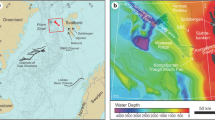Abstract
The Hikurangi Channel, east of New Zealand, is one of the earth's major, active, sediment conduits between rising mountains and ocean basin. About 1500 km long, it uniquely incorporates most variations of canyon—channel systems worldwide. An apical canyon feeds a meandering, aggradational, trench-axis channel. This diverts, 800 km from the source, across an oceanic plateau. There, an oceanic-type channel has become incised over 500 m at the plateau-edge scarp. Beyond the scarp, distributary fan channels supply sediment to the Pacific's Deep Western Boundary Current and one distributary merges into a boundary channel.
Similar content being viewed by others
References
Belderson RH, Kenyon NH, Stride AH, and Pelton CD (1984) A “braided” distributary system on the Orinoco deep-sea fan. Marine Geology 56:195–206
Carter L (1992) Acoustical characterisation of seafloor sediments and its relationship to active sedimentary processes in Cook Strait, New Zealand. New Zealand Journal of Geology and Geophysics 35:289–300
Carter L and Carter RM (1988) Late Quaternary development of left-bank-dominant levees in the Bounty Trough, New Zealand. Marine Geology 78:185–197
Carter L and Carter RM (1990) Lacustrine sediment traps and their effect on continental sedimentation—South Island, New Zealand. Geo-Marine Letters 10:93–100
Carter L and Carter RM (1993) Sedimentary evolution of the Bounty Trough; a Cretaceous rift basin, southwest Pacific Ocean In: Ballance PF (Ed.), Basins of the Southwest Pacific. Sedimentary Basins of the World 3:51–67
Carter L and McCave IN (1994) Structure of sediment drifts approaching an active plate margin under the SW Pacific Deep Western Boundary Current. Paleoceanography, in press
Carter L and Mitchell JS (1987) Late quaternary sediment pathways through the deep ocean. Paleoceanography 2:409–422
Carter L, Carter RM, and Griggs GB (1982) Sedimentation in the Conway Trough, a deep near-shore marine basin at the junction of the Alpine transform and Hikurangi subduction plate boundary. Sedimentology 29:475–497
Carter RM (1988) The nature and evolution of deep-sea channel systems. Basin Research 1:41–54
Damuth JE, Flood RD, Kowsmann RO, Belderson RH, and Gorini MA (1988) Anatomy and growth pattern of Amazon deep-sea fan as revealed by long-range side-scan sonar (GLORIA) and high-resolution seismic studies. American Association Petroleum Geologists Bulletin 72:885–911
Fenner J, Carter L, and Stewart R (1992) Late Quaternary paleoclimate and paleoceanographic change over northern Chatham Rise, New Zealand. Marine Geology 108:383–404
Flood RD (1988) A lee wave model for deep-sea mudwave activity. Deep-Sea Research 35:973–983
Gibb JG and Adams J (1982) A sediment budget for the east coast between Oamaru and Banks Peninsula, South Island, New Zealand. New Zealand Journal Geology and Geophysics 25:335–352
Herzer RH (1979) Submarine slides and submarine canyons on the continental slope off Canterbury, New Zealand. New Zealand Journal Geology and Geophysics 22:391–406
Houtz RE, Ewing J, Ewing M, and Lonardi AG (1967) Seismic reflection profiles of the New Zealand Plateau. Journal of Geophysical Research 72:4713–4739
Lewis KB (1985) New seismic profiles, cores and dated rocks from the Hikurangi Margin, New Zealand. NZOI Oceanographic Field Report 22:37–49
Lewis KB and Pettinga JR (1993) The emerging, imbricate frontal wedge of the Hikurangi Margin. In: Ballance PF (Ed.), Basins of the Southwest Pacific. Sedimentary Basins of the World 3:225–250
Lewis KB, Bennett DJ, Herzer RH, and Von der Borch CC (1985) Seismic stratigraphy and structure adjacent to an evolving plate boundary, western Chatham Rise, New Zealand. In: Kennett JP, Von der Borch CC, et al. (Eds.), Initial Reports Deep Sea Drilling Project 90:1325–1337
Maill AD (1989) Architectural elements and bounding surfaces in channelised clastic deposits: notes on comparisons between fluvial and turbidite systems. In: Taira A and Masuda F (Eds.), Sedimentary Facies in the Active Plate Margin. Tokyo: Terra Scientific pp 3–15
Nelson CH, Carlson PR, Bryne JV, and Alpha TR (1970) Development of the Astoria Canyon-Fan physiography and comparison with similar systems. Marine Geology 8:259–291
Parker G, Fukushima Y, and Pantin HM (1986) Self-accelerating turbidity currents. Journal of Fluid Mechanics 171:145–181
Reed DL, Meyer AW, Silver EA, and Prasetyo H (1987) Contourite sedimentation in an intraoceanic forearc system: Eastern Sunda Arc, Indonesia. Marine Geology 76:223–241
Shimamura K (1989) Topography and sedimentary facies of the Nankai Deep sea Channel. In: Taira A and Masuda F (Eds.), Sedimentary Facies in the Active Plate Margin. Tokyo: Terra Scientific pp 529–556
Thornberg TM and Kulm LD (1987) Sedimentation in the Chile Trench: Depositional morphologies, lithologies, and stratigraphy. Geological Society America Bulletin 98:33–52
Walcott RI (1984) Reconstructions of the New Zealand region for the Neogene. Palaeogeography, Palaeoclimatology, and Palaeoecology 46:217–231
Wood RA and Davy BW (1994) The Hikurangi Plateau. Marine Geology, in press
Author information
Authors and Affiliations
Rights and permissions
About this article
Cite this article
Lewis, K.B. The 1500-km-long Hikurangi Channel: Trench-axis channel that escapes its trench, crosses a plateau, and feeds a fan drift. Geo-Marine Letters 14, 19–28 (1994). https://doi.org/10.1007/BF01204467
Received:
Revised:
Issue Date:
DOI: https://doi.org/10.1007/BF01204467




